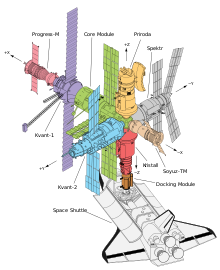Shuttle Docking Module
The Shuttle Docking Module ( SDM ) was a module of the Mir space station that was jointly developed by the Russian and US space agencies to couple space shuttles to the Mir space station.
development
Initial considerations in the then Soviet space program envisaged a special docking module with the designation "SO" ( Russian Стыковочный Отсек ) with which the Buran space shuttle could have docked at the planned Mir-2 space station. After a concept dating back to 1992, the module should also feature an air lock for outdoor use are equipped with the help of a Progress docked -Servicemoduls to the Mir-2.
After the collapse of the Soviet Union , the Buran program and the development of the Mir-2 space station were stopped for financial reasons. At the same time, it was decided to move closer to the US space program and flights of the US shuttle to Mir were planned. During the STS-71 mission for the first docking of the space shuttle to the Mir, the crystal module had to be laboriously moved to the radial position on the Mir coupling adapter so that the space shuttle Atlantis does not touch and damage the Mir or its superstructures. After that, the crystal had to be moved back to its original position in order to clear the radial docking point for Soyuz spaceships and Progress feeders.
In order to avoid this complex implementation and the associated external missions on the follow-up missions, American and Russian experts agreed on the development of a special docking module to expand Kristall. With the 4.70 meter long and 6 tons heavy module, the distance between the shuttle and Mir should be increased so that there is no contact and the exhaust gases from the shuttle control nozzles do not affect the Mir and especially its sensitive solar panels .
The plans for the Mir-2 docking module "SO" from the Russian manufacturer RKK Energija were used to develop the module quickly . In order to shorten the construction time, this module has been simplified and the installation of the air lock for outdoor use has been dispensed with. Furthermore, parts of the construction could be derived from the Soyuz orbital module, as this had already been tested in the Soyuz TM-16 mission with the APAS 89 docking adapter required for coupling to the crystal . Most of the construction took place in Russia and the SDM was delivered to the Kennedy Space Center on June 7, 1995 .
Start and installation
The Shuttle Docking Module was the only module of the Mir space station that was not launched into space with the help of a Proton rocket . On November 13, 1995, the SDM was launched as a payload on the US space shuttle Atlantis ( STS-74 ). On the second day of the flight, the SDM was lifted out of the loading bay and placed on the coupling adapter of the Atlantis. On November 16, the coupling to the axial APAS docking point of the crystal module and thus the second mooring of a space shuttle at the Mir space station took place.
As a special feature, two large transport containers with folded solar panels were attached to the outer wall of the SDM. One of the two panels was developed and manufactured with US participation. After docking the SDM to the Mir, the two panels were attached to the Kwant module to improve the power supply to the Mir complex. After the Atlantis was cast off, the SDM remained on the Mir, so that it could be used to dock a space shuttle seven times in the following years.
Scientific tasks
The main task of the SDM was to create and research the basic requirements for coupling a space shuttle to a space station. During the joint Shuttle Mir flights, several investigations were carried out to check the stability of the entire complex and the effects of ignition of the control engines. Furthermore, with the help of the coupling module in the Shuttle-Mir program, the integration of the shuttle as a supply vehicle and the loading and unloading of supplies were tested. The SDM also had its own temperature control system and equipment for transmitting radio and television data. On the outer wall of the SDM there were measuring devices for checking the effects of cosmic rays on the space shuttle as well as space for further experiments. During an outboard mission as part of the STS-76 shuttle mission, four experiments were mounted on the outer skin of the shuttle docking module. These were used to research micrometeorite impacts and the effects of dust particles. Furthermore, materials for the construction of the International Space Station (ISS) were researched.
Conclusions
The use of the docking module enabled eight Shuttle-Mir missions to be carried out and the shuttle to be included in the Mir's supply plan. In addition to the delivery of supplies and crew members, the shuttle also made it possible to take completed experiments and equipment that is no longer required back to earth. Since this is only possible to a limited extent in Soyuz landing capsules, the research opportunities on the Mir were further increased by using the shuttle. From the successful use of the SDM, essential findings for modules of the ISS were adopted. On the one hand, the docking module Pirs , which is currently used on the ISS for docking Soyuz and Progress ships, was developed on the basis of the SO or SDM module. On the other hand, NASA uses the APAS docking system both in the shuttle itself and in the three PMA modules of the ISS for docking shuttles and as a transition between the US and Russian segments.
swell
- Harland, David M .; The story of Space Station Mir , Springer-Verlag, Berlin Heidelberg, New York 2005, ISBN 0-387-23011-4




